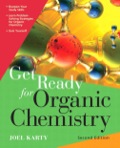
Concept explainers
Interpretation:
Two different ways of synthesizing the given compound via carbene addition by using a different alkene are to be provided.
Concept introduction:
A carbene is a species containing a carbon atom that has two bonds and a lone pair of electrons. Carbenes are typically highly electrophilic due to the lack of an octet and are
Chloroform is a precursor to generate a carbene. When an alkyl trihalide is treated with a strong base in the presence of cyclohexane, a dihalocarbene is generated in two steps via
In an electrophilic addition reaction,
Want to see the full answer?
Check out a sample textbook solution
Chapter 12 Solutions
EBK GET READY FOR ORGANIC CHEMISTRY
- Provide a complete, detailed mechanism for the reaction CH;CH,OH shown here.arrow_forwardBonus Question: If you deemed the previous reaction to be unsuccessfull, propose a reaction or synthesis that would successfully produce the desired ether product (shown again to the side). You may use any reaction you know of.arrow_forwardPlease explain in detail, thank you!arrow_forward
- (SYN) Each of the following compounds can be produced from an alkene, using a single electrophilic addition reaction.Write that reaction and draw its complete, detailed mechanism. (a) 4-chloro-1,2-dimethylcyclohexane; (b) 1-chloro-1,2-dimethylcyclohexane; (c) 1-bromo-1,1-diphenylbutane; (d) 2,2-dichloropentanearrow_forwardThe reaction shown here is an example of the Favorskii reaction, which involves an R¯ leaving group in a nucleophilic addition-elimination reaction. (a) Draw the complete, detailed mechanism for this reaction and explain why R can act as a leaving NaOH H2O group. (b) Suggest how you can synthesize an ester from cyclopropanone using only this reaction.arrow_forward(SYN) Show how to produce each of the following compounds from a hydrocarbon that has the formula indicatedarrow_forward
- Problem attachedarrow_forwardDraw the complete, detailed mechanism for the reaction shown here. Will the product be optically active? Explain.arrow_forwardHelp! Please explain in detail. Thank you! Avobenzone is an active component in many sunscreens. It can exist in an equilibrium between its keto and enol forms. The enol from of avobenzone is given below. (A) Draw the keto form of this compound (B) Which tautomer (keto or enol) exists in a higher equilibrium percentage? Explain your reasoning.arrow_forward
- (a) Predict the product of the set of reactions shown here. (b) Draw the complete, detailed mechanism for the formation of the synthetic intermediate that is not shown.arrow_forwardHelp! Please explain in detail, thank you!arrow_forwardProblem (a) Why is the following reaction a poor method for the synthesis of t propyl ether? (b) What would be the major product from this reaction? (c) Propose a better synthesis of t-butyl propyl ether. does not CH, give ÇH, CH,CH,CH,-0:- *Na + CH,-Ċ-Br CH;-Ç-0-CH,CH, CH, CH, sodium propoxide 1-butyl bromide r-butyl propyl ctherarrow_forward
 Organic Chemistry: A Guided InquiryChemistryISBN:9780618974122Author:Andrei StraumanisPublisher:Cengage Learning
Organic Chemistry: A Guided InquiryChemistryISBN:9780618974122Author:Andrei StraumanisPublisher:Cengage Learning
